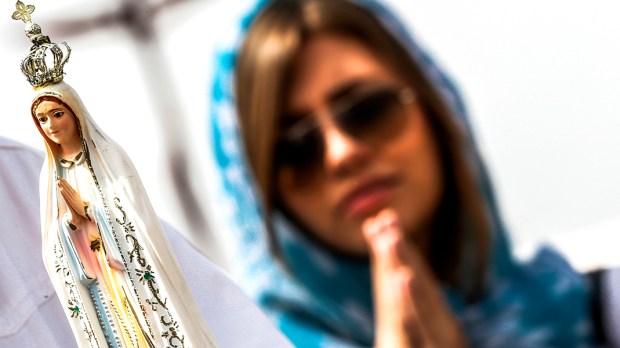Lenten Campaign 2025
This content is free of charge, as are all our articles.
Support us with a donation that is tax-deductible and enable us to continue to reach millions of readers.
When Our Lady appeared to the three shepherd children at Fatima in 1917, she allowed them to see a vision that would scare any child (or adult). They saw before them a “vast sea of fire” and in it, many souls being tormented.
It was a frightful image, one that Sister Lucia later commented on, saying, “That vision only lasted for a moment, thanks to our good Heavenly Mother, Who at the first apparition had promised to take us to heaven. Without that, I think that we would have died of terror and fear.”
The Catechism affirms the existence of hell, but describes a more severe punishment than being burned for eternity.
The teaching of the Church affirms the existence of hell and its eternity. Immediately after death the souls of those who die in a state of mortal sin descend into hell, where they suffer the punishments of hell, ‘eternal fire.’ The chief punishment of hell is eternal separation from God, in whom alone man can possess the life and happiness for which he was created and for which he longs (CCC 1035).
The explanation the Catechism gives is why we should be afraid of hell. We should fear the prospect of spending eternity separated from the God who loves us so much.
While it is true the the children saw hell depicted as a sea of fire, Sister Lucia noted how those in hell were suffering from immense “despair.” Hell is a place of utter desolation, a lonely place — not at all the “party of sinners” so many people envision.
Dante wrote about this aspect of hell in his Inferno. In contrast to a”vast sea of fire,” he describes it as a lake of “ice.” In particular, Satan is waist-deep in ice and is seen crying:
The Emperor of the kingdom dolorous From his mid-breast forth issued from the ice;With six eyes did he weep, and down three chins Trickled the tear-drops and the bloody drivel (Canto XXXIV).
Instead of a place of perpetual burning, it is seen as a place of darkness, cold and despair. Dante’s image of hell highlights the reality of eternal separation from God, something terrible and extremely lonely. In this depiction of hell, it is a place where you cry out, but nobody hears your cries; a place where you desire to be next to someone, but can never move.
The good news is that Our Lady did not simply show this vision to the children to scare them. She wanted them to know why we should strive to avoid hell and why we should do all that we can to run toward heaven, bringing with us everyone we know.
She also offered a pathway that would lead souls to the heavenly embrace.
You have seen hell where the souls of poor sinners go. To save them, God wishes to establish in the world devotion to my Immaculate Heart.
Our Lady taught the children to draw close to her Immaculate Heart in order to save their souls from straying away from God. She recommended practicing the First Saturday devotions, offering personal sacrifices and also praying an additional prayer during the Rosary.
When you pray the Rosary, say after each mystery: “O my Jesus, forgive us, save us from the fire of hell. Lead all souls to heaven, especially those who are most in need.”
This prayer (more commonly prayed as, “O my Jesus, forgive us our sins, save us from the fires of hell, lead all souls to heaven, especially those most in need of Thy mercy. Amen.”) is one that reminded the children of their vision of hell, awakening in them a desire to save souls every time they prayed the Rosary.
The prayer summarizes our Christian life, recognizing our need for personal forgiveness, but also directing our efforts to help those around us reach the joys of heaven. Our Lady of Fatima reminds us that we should desire all souls to reach heaven, even our enemies. We should never wish someone would spend eternity separated from God.
In the end, the closer we draw to Mary’s heart, the closer we will be to Jesus’ heart. As St. Louis de Montfort wrote, devotion to Mary “is the safest, easiest, shortest and most perfect way of approaching Jesus.”
Read more:
5 Things to Know About First Saturdays

